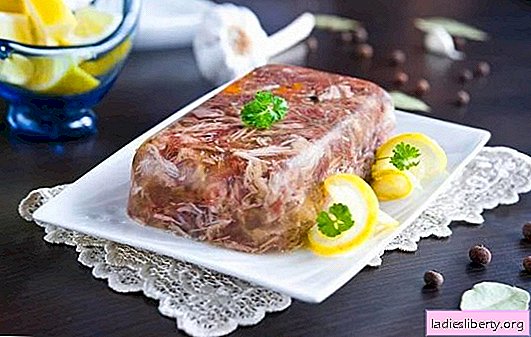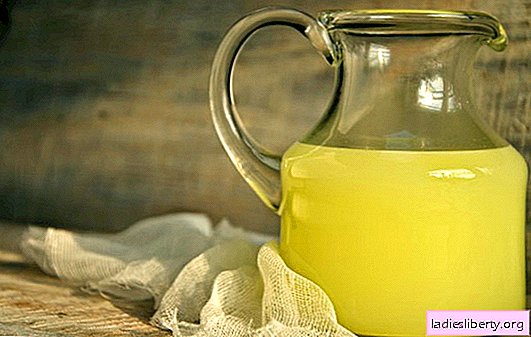
Appetizer - an attribute of the festive table, cold or hot dish, which is served before the main dishes. Contrary to rumors, alcohol was not invented in Russia, and the ancestors did not drink anything stronger than kvass or full (a drink of honey and water). The wine that appeared with the advent of Christianity from Byzantium was for a long time considered only a ritual drink, and not an aperitif.
That is, there was no need for a snack as an addition to alcohol for quite a while, until foreigners opened the first restaurants in Russia. "Our ancestors ate swiftly" is no longer about the modern Russian culture of a festive feast. Now the classic ideas about holiday feasts and the rules for serving refreshments have changed a lot: a buffet consisting of snack dishes has come into fashion, and sandwiches in general can be taken with you to work as a full dinner.
Many dishes that existed in ancient Russian cuisine on their own, without aperitifs, simply went into the category of snacks with the advent of the tradition of drinking strong drinks. But, apart from what has been said, there are other rules that do not recommend, for example, snacking on wine with pickled mushrooms or pickles. What is customary to serve as a snack in Russian cuisine? We'll figure out.
Russian appetizer - the basic principles of cooking
To talk about what to serve as a Russian snack, you need to take into account the features of our cuisine that have developed centuries ago under the influence of objective historical and geographical factors, as well as current trends in its development.
A vast territory, forests and rivers are an abundance of fish, game, mushrooms and berries, which became the basis of the diet of ancestors. Severe climatic conditions made it necessary to take care of preserving stocks in the winter - this is how the first Russian snacks appeared: sauerkraut, pickles and mushrooms, soaked berries, layered salted fish. Until now, in many southern countries there is no such way of cooking products as canning, pickling, pickling. Therefore, there is reason to believe that it was the salty, pickled and pickled products that the foreigners called the Russian snack, which is very harmoniously combined with strong drinks.
In addition to vegetable snacks, Russian cuisine has a tradition of serving meat, fish and cheese snacks. The usual cut with a beautiful design is a purely Russian tradition, because in the old Russian cuisine even salads for a long time consisted of one component: a salad of pickled beets, a salad of cucumbers, a salad of sauerkraut and so on. The preparation of such an appetizer was limited to one of the types of cold or hot processing: pickling or salting, or cooking or baking. A supplement to such dishes was sour dressing made of sour cream or vinegar, with spices and herbs, the assortment of which in Russia was already quite extensive in the ninth century.
Influenced by the cuisine of Western countries, starting from the mid-eighteenth century, the preparation of cold snacks became more complicated: salads became multicomponent, and, complex in composition, vinaigrette is still considered a Russian salad in the West. Complex salads are a feature of modern Russian cuisine, along with simple slices.
Vegetable snacks have also undergone profound changes under the influence of the cuisine of neighboring nations. Tomatoes, cucumbers, eggplant, peppers, zucchini, previously unknown products in Russian cuisine, are now served as a snack in a fresh, fried or stewed form. Canned vegetables and salads are very popular on the Russian table.
The emergence of salads, sophisticated methods of heat treatment and chopping of products, Russian cuisine is obliged to the French. Sandwiches are the influence of the German culinary tradition, but in the Russian version they are much more interesting, because they are not limited to two components. Brot and Butter - bread and butter, in the modern Russian version, appetizers are decorated with salted fish or caviar, cheese, slices of boiled pork, ham, and other components. The preparation of sandwiches for a buffet in Russian was not without the influence of Italian, French, American cuisine, as evidenced by the appearance of canapes, crostini, bruschetta, sandwiches, tapas.
As appetizer dishes, dishes are served from minced meat, fish and vegetables, in cold and hot form: sausages, meat and fish rolls, stuffed eggs, vegetables, pastes, vegetable caviar.
Preserving its own traditions, Russian cuisine continues to develop and enrich due to the variety of dishes not only from neighboring nations, but also collecting recipes for snacks even on other continents. This is the main principle of Russian cuisine - in the breadth of the assortment, generosity and hospitality, in the desire to understand and accept the culture and traditions of other nations. Therefore, if you need to adequately meet the guests, just serve on the table what is in the house at this moment, not forgetting to decorate the treat, as was the custom in Russia.
1. Russian appetizer: stewed eggplant with tomatoes (saute)
Products:
Tomatoes (meaty varieties) 1 kg
Eggplant 1.7 kg
Salad pepper 350 g
Sour apples 300 g (net)
Onion, 0.5 kg
Red carrot 400 g
Garlic 90 g
Refined oil 125 ml
Black, allspice, red hot ground pepper
Coriander
Bay leaf
Salt
Tomato Paste 150 g
Cooking:
Eggplant, peeling sepals and peels, cut into cubes (2-3 cm), soak in saline for about an hour to remove the bitterness and rinse with clean water. Dry on a napkin. Grate carrots and chop onions. Take the meaty varieties of peppers and tomatoes for a snack, blanch, remove the skin and seeds, cut into cubes.
Fry vegetables until they are rosy in color, then use a slotted spoon to transfer them to a sieve, allowing excess oil to drain.
Transfer the fried eggplant, tomatoes and peppers to a saucepan, and return the onions and carrots to the pan. Grate peeled apples, and also add to the pan. Pass the dressing for 10-15 minutes, then add the tomato paste, spices and salt, mix and let it boil. Kill the hot mass with a blender until smooth, pour into a saucepan and simmer vegetables until cooked, over medium heat, without covering. Before removing from the stove, check the taste, lay chopped garlic. Now cover the stewpan with a lid and wrap it with a warm cloth for half an hour.
The main point is the design and serving of snacks, in the Russian style - very beautiful. Sauté served hot and cold. Arrange a hot appetizer in bowls or portioned snack plates with a slide. Put “petals” around - potato chips, slices of tomatoes or slices of fresh cucumbers. Sprinkle with chopped herbs. Snack can be served in sand baskets or come up with your own design options.
2. Russian snack from zucchini - "caviar overseas"
Eggplant and zucchini everywhere spread in Russian cuisine only in the twentieth century, in the Soviet period, but became a favorite ingredient for appetizers and side dishes.
Product Composition:
Zucchini 1.3 kg
Onion 400 g
Carrot 300 g
Red pepper salad 400 g
Tomatoes 800 g
Garlic 0.5 Heads
Vegetable oil 120 ml
Table vinegar (9%) 75 ml
Tomato paste 100 g
Salt to taste
Red hot and black pepper
Cooking method:
Chop the onions and grate the carrots. Pass the vegetables in vegetable oil until soft. Peel the tomatoes. To do this, cut and dip them in hot water for a short while. Peel the zucchini and peppers. Cut the vegetables into medium sized cubes. Pour the tomato juice in a tomato and boil until soft. Wipe through a sieve to remove seeds - so the caviar will look more beautiful. Add pepper to the fry and simmer for five minutes, then add the tomatoes, and continue to simmer another ten minutes. Send zucchini to the vegetables, pour in the vinegar, season with spices and salt. Cover and simmer for 40-45 minutes, stirring continuously. Kill the finished caviar with a blender. Serve cold with a large amount of greens.
3. Russian appetizer - pancakes with caviar
Classics are Russian pancakes, and nowadays, unfortunately, is luxury, for especially solemn occasions. But, if there are problems with caviar, use herring oil or chop finely salted salmon, chum salmon, pink salmon.
Ingredients:
Vegetable oil 150 ml
Boiled water 100 ml
Milk (3.2%) 300 ml
Eggs 3 pcs.
Salt 12 g
Flour 350 g
Soda 10 g
Sugar 25 g
Butter, melted 125 g
Red caviar 250 g
Hard cheese 200 g
Chives 80 g
Cooking:
Combine flour, soda, sugar and salt. Beat the eggs in a froth, add water and milk. Pour the liquid gradually into the dry flour mixture, stirring the dough with a whisk. Pour in refined vegetable oil. Leave the finished pancake dough for half an hour to better gluten.
Take a pancake pan with a diameter of 20-22 cm, heat well, and bake pancakes, pouring the dough in equal portions. Grease hot pancakes with melted butter.
Make a snack: wrap caviar, putting one spoon in the center of each pancake; gather the edges with a skirt, tie with green feathers of onions. Serve, handsome cheese sliced. Pancakes can also be rolled up with tubules or pockets.
4. Studen - a cold Russian snack
Ingredients:
Pork legs 4 kg
Chicken legs 3 kg
Beef tails 2 kg
Beef tenderloin 3 kg
Carrot 0.5 kg
Garlic 100 g
Onions 0.3 kg
Bay leaf 10 g
Salt 75 g
Black pepper (peas)
Water 8 L
Parsley (fresh leaves)
Mustard sauce, table horseradish - for serving
Cooking:
Soak the meat overnight in cold water, then wash. Fillet and chicken temporarily set aside. Fold your legs and tails in a large saucepan, pour clean water. Other carcass parts containing a large amount of cartilage can be used.
Peel the carrots and onions. Put the pan on low heat, bring to a boil, removing the foam. Put the whole root vegetables, cook the broth for three hours. The readiness of the broth is checked with a knife or fork, which should pierce the skin freely, and at the end of cooking, the legs and tails should be completely boiled. Add the prepared fillet and chicken legs to the broth. Cook in the same mode again for up to 1.5 hours. Add the fragrant spices with the pulp.
During cooking, the amount of liquid is reduced to 40%. Turn off the heat, transfer the meat to a dish, and add the peeled and minced garlic to the broth.
When the broth and meat have cooled to 20-25 ° C, strain the broth (it should be transparent), cut the meat into cubes. Put cooked carrots, sliced in slices, parsley leaves in portioned dishes. On top, put the boiled meat, cut into cubes, fill the forms with broth. Place the jellied meat in the refrigerator, covering the forms, until completely solidified.
When submitting the form, warm it slightly, lowering it in boiling water, turn it on a snack plate or a large dish.
5. Russian snack: stuffed tomatoes with mushrooms
Products for cooking:
Large tomatoes 8-10 pcs.
Pickled champignons 250 g
Boiled potatoes 180 g
Green onion 50 g, onion -120 g
Mayonnaise 75 g
Cooking:
Boil potatoes and eggs and cut into small cubes. Grind onions and mushrooms. Mix and season with mayonnaise. Salt. Cut the star shape at the top of the tomatoes and spoon out the core, turn over, leave for a while, until the juice drains. Spread the filling in the middle, chop the green onions and sprinkle on top.
Put the appetizer on a dish decorated with herbs.
Russian appetizer - useful tips and tricks
If leafy greens, fresh vegetables, mayonnaise are used to prepare the appetizer, then you should start cooking it no earlier than a couple of hours before the start of dinner in order to maintain the freshness and beautiful appearance of the dish.
Slices, meat, fish or cheese can be prepared in advance to serve all the dishes by the appointed time, but so that the slices are not weathered, put them in containers (individually!), Close with lids. You can beautifully lay it on plates and wrap it on top with a film. Before serving, remove the plates with the appetizer in the refrigerator.
Make sure that the snack foods are sure to match the spirits served on the table:
To vodka - fatty, spicy, salty: pickled mushrooms, cucumbers and other pickles, jelly. You can serve pies and pancakes, herring, mincemeat, corned beef, balyk and other smoked meats;
To white wine - white meat and fish are some varieties of cheese;
To red and tart wine - red types of meat, also cheeses;
For dessert wines - fruits, salads and fruit desserts;
To sparkling wines - seafood;
For beer - smoked cheeses, salted fish, pizza, chips;
To cognac - cheeses, chocolate, fruits, lean meat.
Serve cold snacks for strong drinks, and hot snacks for lighter types of alcohol.











